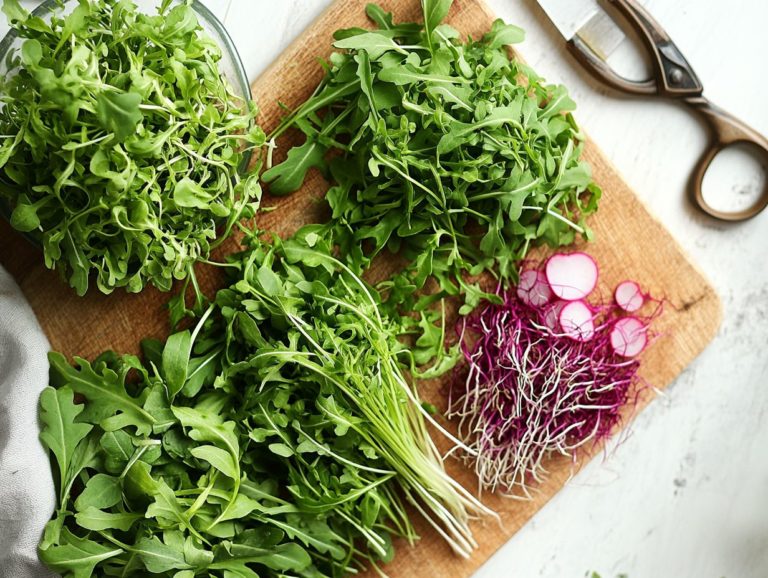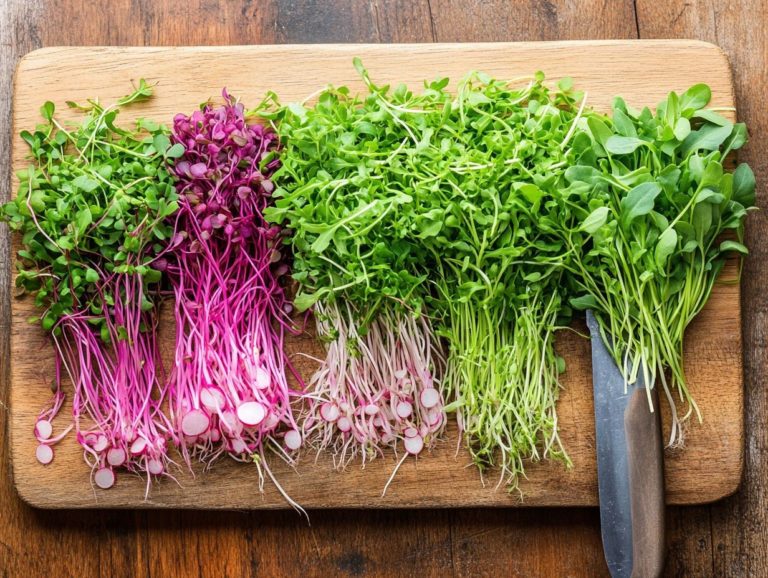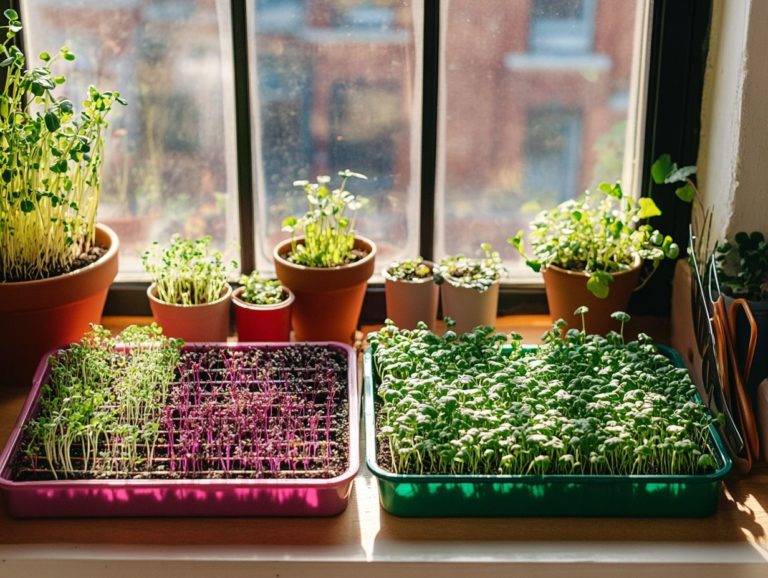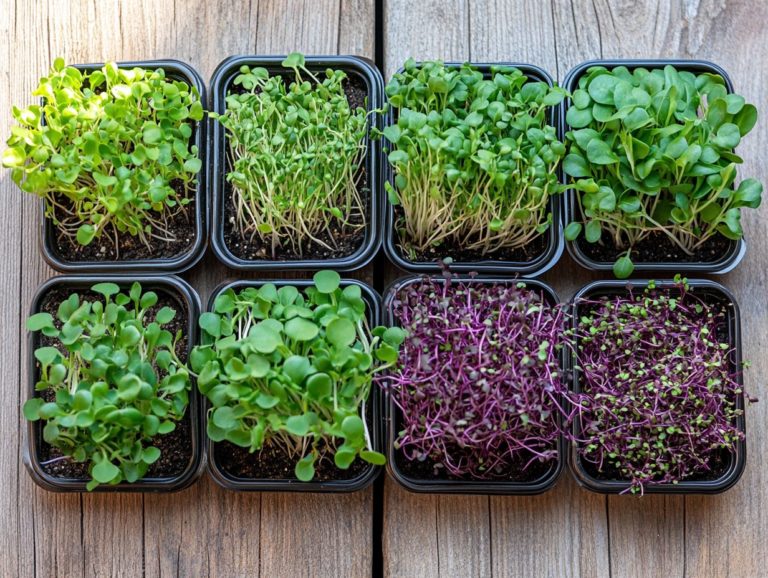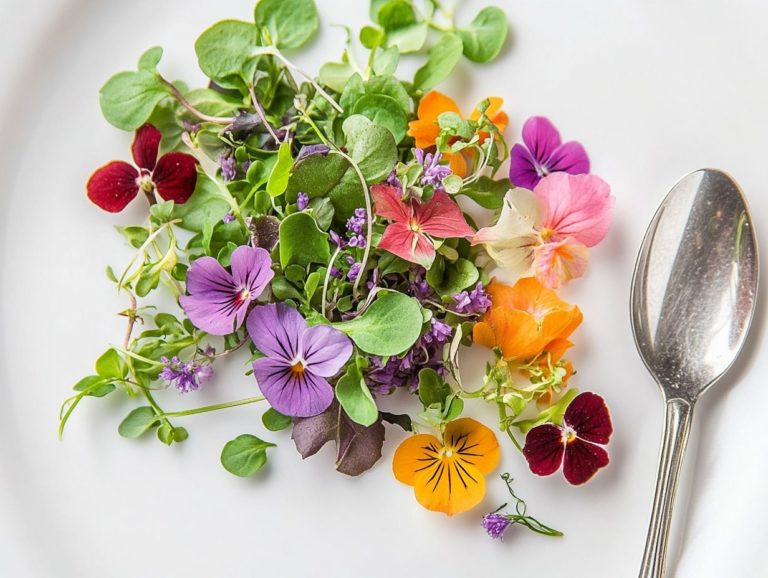Quick Guide to Common Microgreen Varieties
Microgreens are remarkable little plants that pack a punch in both flavor and nutrition, transforming any dish into a culinary masterpiece.
They bring a wealth of benefits, offering impressive nutritional value. You ll discover popular microgreens and effective methods for cultivating them right in your own home, including the best microgreens suited for indoor gardening.
You ll also find essential tips for harvesting and storing flavorful microgreens, ensuring they remain fresh and delightful.
Get ready to transform your meals with these amazing little powerhouses!
Contents
Key Takeaways for Growing Microgreens:
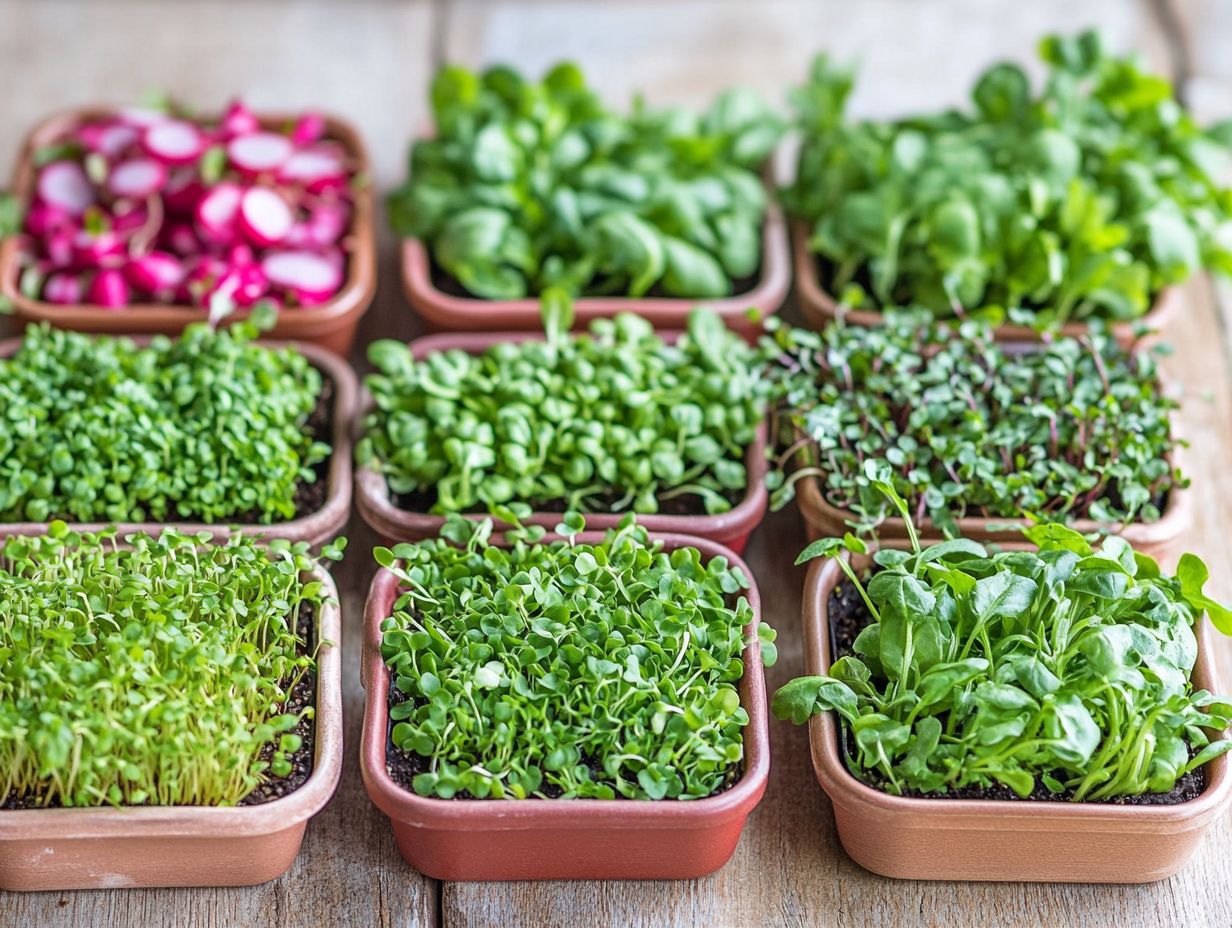
- Microgreens are young, full of nutrients plants that are easy to grow at home, making them perfect for urban farming enthusiasts or novice gardeners.
- There are various types of microgreens, with popular varieties including broccoli, sunflower, and radish, each offering unique health benefits.
- Follow a step-by-step guide for growing, harvesting, and storing microgreens, including tips on using a microgreens kit to ensure maximum freshness and nutritional value.
What are Microgreens?
Microgreens are those delightful young, edible plants you can harvest at an early growth stage. They ve earned quite the reputation for their impressive nutrient profile, vibrant flavors, and versatility in cooking. You ll often find these petite greens gracing dishes as garnishes or nestled in salads, with varieties like broccoli, kale, and arugula making them a favorite among health-conscious individuals eager to add superfoods to their diets.
With a spectrum of flavors ranging from mild to spicy, microgreens not only elevate your dishes but also play a significant role in fostering healthy eating habits.
Their compact leaves and striking colors create a feast for the eyes. Everything from the sweet essence of pea shoots to the bold kick of radish greens appeals to both seasoned chefs and home cooks. As more people discover the myriad health benefits these tiny powerhouses offer like high levels of vitamins A, C, and K, along with essential minerals their popularity continues to soar.
Cultivating microgreens is a breeze, whether you choose to nurture them indoors by a sunny window or let them flourish outdoors in the garden. This gives you the flexibility and accessibility you need. This rising interest not only sparks culinary creativity but also champions sustainable eating habits, showcasing the delightful diversity found in the world of microgreens.
Benefits of Growing Microgreens
Growing microgreens presents a wealth of advantages, including exceptional nutritional value and remarkable adaptability to various growing conditions. This makes them the perfect choice for both urban farming enthusiasts and novice gardeners.
These superfoods are packed with nutrients and can be effortlessly cultivated indoors. They offer a fresh source of essential vitamins and minerals. Their easy growth process suits anyone looking for simple gardening tips for healthy eating.
Nutritional Value of Microgreens
Microgreens are celebrated for their remarkable nutritional profile, often containing higher concentrations of vitamins, minerals, and antioxidants than their fully matured counterparts. This makes them a true powerhouse for anyone committed to healthy eating. Their convenience in enhancing both flavor and nutrition means you can elevate your dishes effortlessly, all while promoting your overall wellness.
Take kale microgreens, for example; they are bursting with vitamins A, C, and K, outshining mature kale. And radish microgreens? They add a delightful spicy kick along with a hefty dose of antioxidants. For those interested in maximizing their nutrition, exploring the best microgreens for nutritional value is a great idea. These tiny but mighty plants can be effortlessly sprinkled on salads, stirred into soups, or blended into smoothies, transforming them into a versatile addition to any meal.
By incorporating microgreens into your diet, you provide a swift way to boost your nutrient intake without changing your cooking times or methods. This makes them the perfect choice for anyone looking to embrace both convenience and a healthier lifestyle.
Start your microgreens journey today and enjoy fresh flavors in your meals!
Types of Microgreens
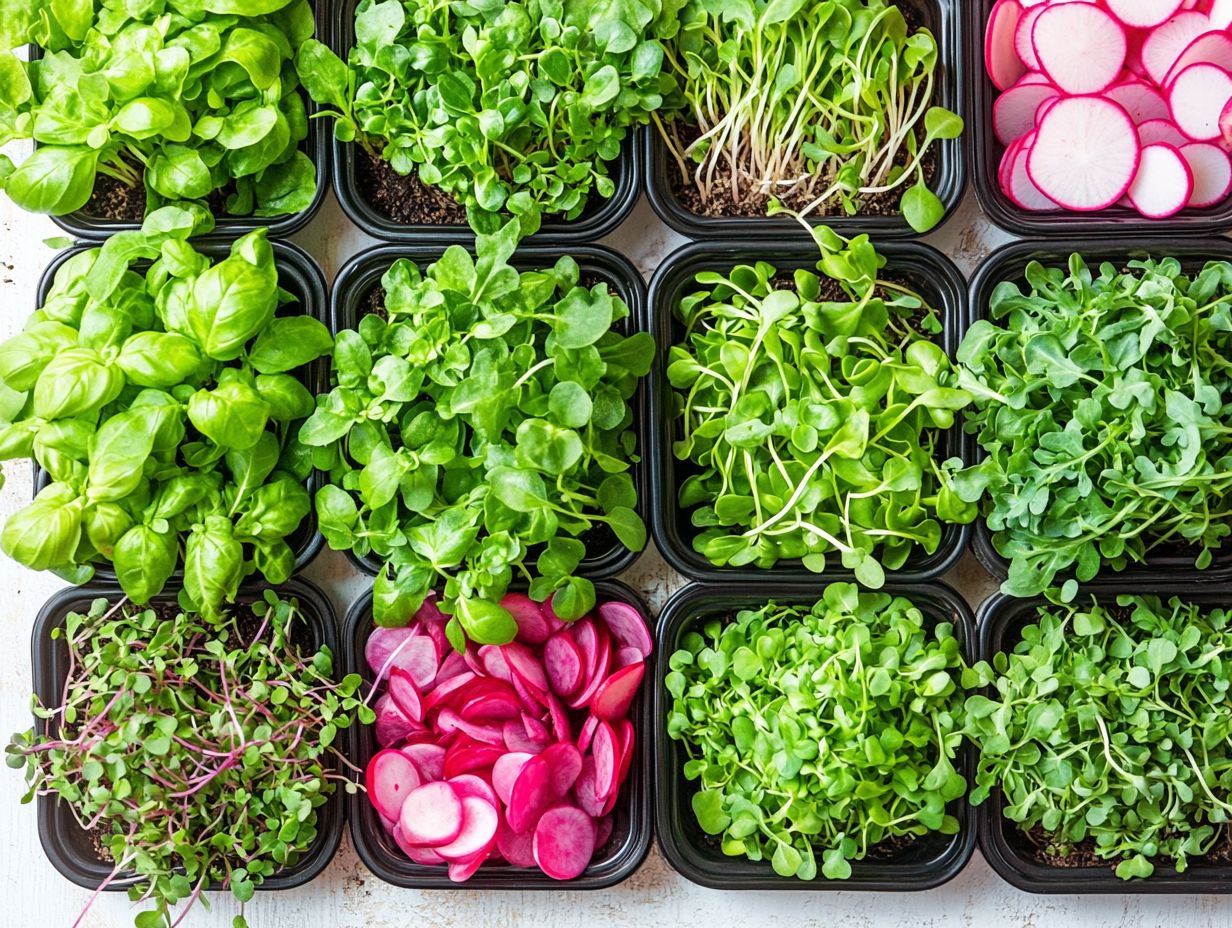
You ll find a remarkable variety of microgreens. Each brings its own distinct flavors, textures, and nutritional benefits, making them a delightful addition to any dish.
Popular choices like broccoli, kale, and radish not only boost health but also offer a range of tastes from mild to spicy. They cater to your diverse culinary preferences.
Basil, cilantro, and dill also add aromatic notes to your meals. These microgreens highlight the incredible versatility they bring to your kitchen creations.
Popular Varieties and Their Uses
Explore some of the most popular microgreens such as Alfalfa, Broccoli, Kale, and Radish. Each boasts unique flavor profiles and ways to use in cooking that can elevate your dishes. Alfalfa brings a mild flavor, while Mustard microgreens deliver a peppery kick, perfect for salads, sandwiches, and garnishes enhancing both flavor and nutrition.
Broccoli microgreens are celebrated for their delicate earthy taste. They pack a surprising punch of nutrients, with high levels of vitamins C and K. These microgreens make an exceptional addition to smoothies or serve as a delightful topping on toast.
Kale microgreens have a slightly sweet and robust flavor, making them ideal for saut ing or blending into soups. They provide a wealth of vitamins A and K.
Meanwhile, Radish microgreens add a zesty note that can elevate any dish, particularly tacos or grain bowls, showcasing their flavorful profile.
The varied textures and flavors of these microgreens open up a world of creativity in the kitchen, transforming simple meals into vibrant culinary experiences.
How to Grow Microgreens
Growing microgreens is a truly rewarding pursuit that demands little in terms of space and equipment. It s an ideal indoor gardening experience for anyone with a passion for plants.
With a microgreens kit, you’ll find it effortless to cultivate a diverse range of varieties. You can use either soil or hydroponic methods, providing you with the flexibility to grow these nutritious superfoods in a way that suits your lifestyle.
Follow these simple steps to grow your microgreens! Even those just starting out can thrive, savoring the delightful flavors of homegrown microgreens while reaping the many benefits of fresh produce.
Step-by-Step Guide
To successfully grow microgreens, start with selecting the right microgreens kit and preparing your growing medium, whether you choose soil or hydroponic systems. Ensure optimal light, moisture, and temperature conditions to cultivate flavorful microgreens at home and relish the fruits of your labor in just a few weeks.
Your journey begins with choosing the right microgreen seeds based on their flavor profile and nutritional value. Popular varieties include basil, radish, and arugula. If you opt for soil-based methods, select an organic potting mix to ensure it’s free of pesticides and fertilizers. Alternatively, hydroponic systems can benefit from nutrient-rich water solutions designed for plants. For a comprehensive approach, refer to our step-by-step guide to sowing microgreens.
Once your growing medium is ready, sow the seeds densely, as microgreens thrive in close quarters. Mist them gently and cover them with a humidity dome or clear cover to maintain moisture until germination.
As they sprout, provide ample light preferably through grow lights to promote healthy growth. Regularly monitor water levels and adjust nutrient solutions for hydroponic setups to enhance their development.
In just 7 to 14 days, you can harvest your fresh microgreens, adding a burst of flavor to meals or enjoying them as nutritious snacks.
Harvesting and Storing Microgreens
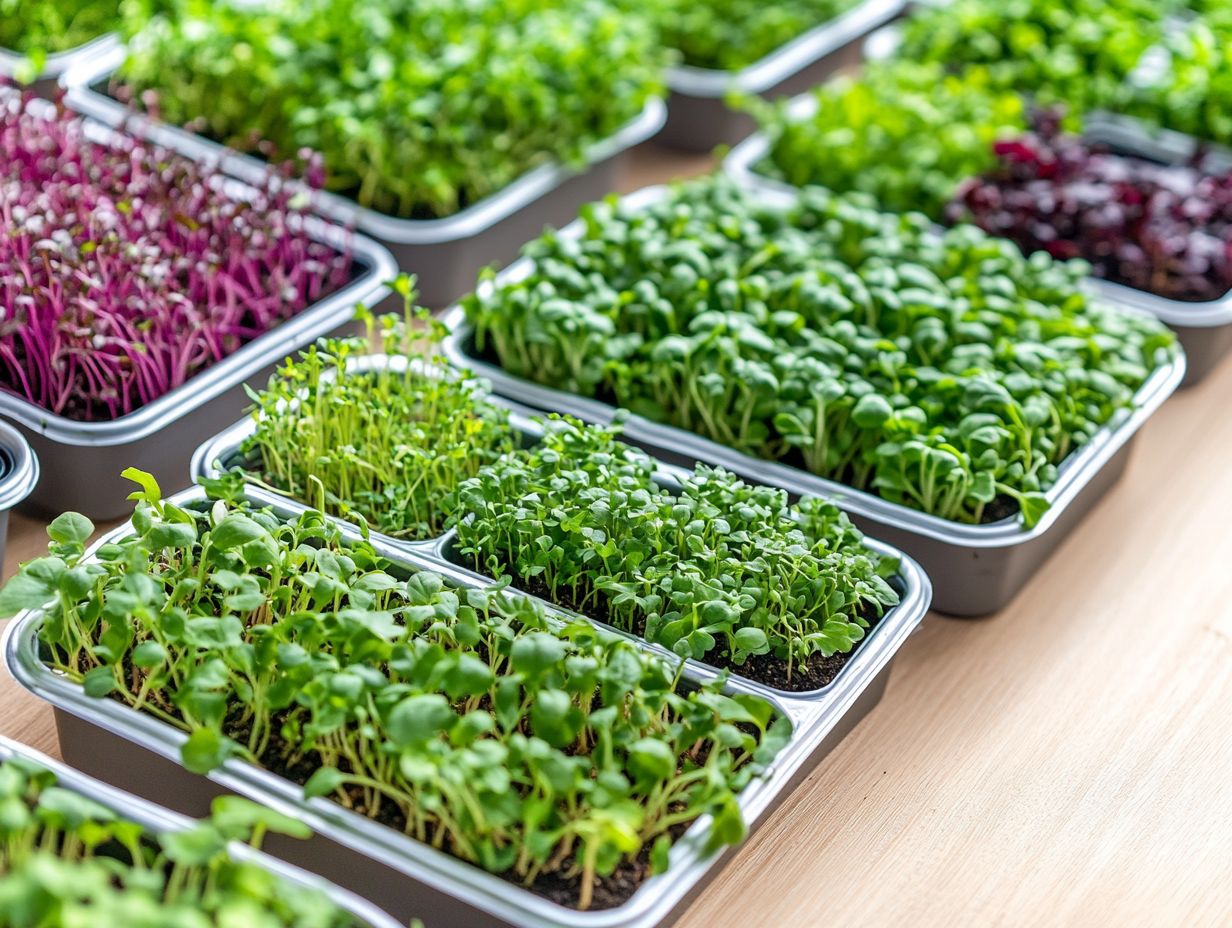
Harvest microgreens carefully. This preserves their freshness and health benefits.
Attention to detail ensures they maintain their vibrant flavors and nutritional value.
Follow best practices when harvesting. This lets you enjoy tiny greens at their peak and enhances your commitment to healthy eating.
Best Practices for Maximum Freshness
To achieve maximum freshness, harvest microgreens just before use. This enhances their flavor profile.
Keep the greens in a container with holes for airflow and in a cool environment to prolong their shelf life.
Controlling temperature during harvesting and storage is key. Ideally, keep microgreens between 34 F and 40 F to prevent wilting and preserve nutrients.
Manage moisture levels carefully. Use paper towels to soak up extra moisture and store your greens in perforated bags for the best results!
These techniques help preserve the quality of your microgreens. They will retain their vibrant colors and crunchy textures, making them an irresistible addition to any dish.
Frequently Asked Questions
What are microgreens?
Microgreens are young, edible plants harvested at the seedling stage, after true leaves develop but before full maturity.
What are the benefits of growing microgreens?
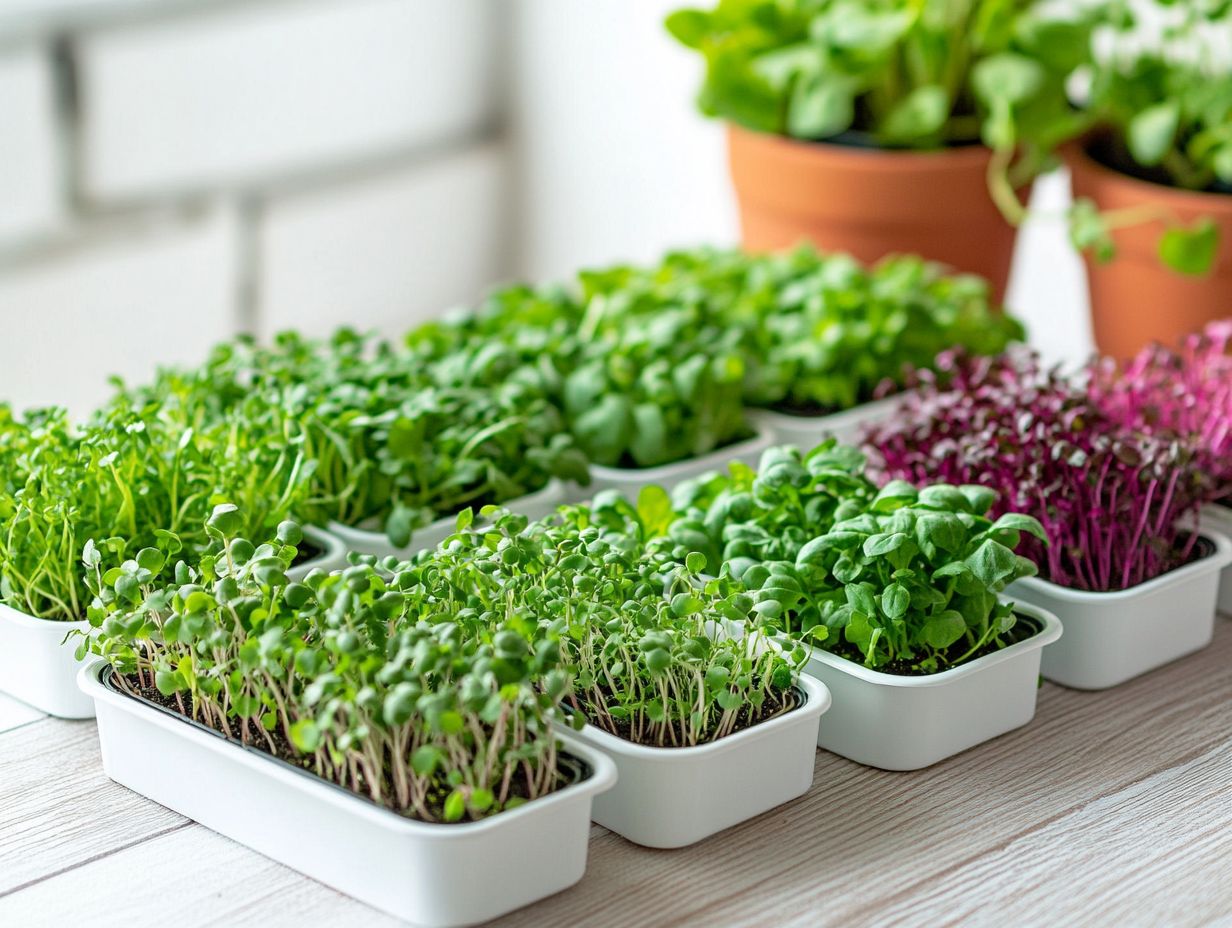
Microgreens are nutrient-rich and packed with antioxidants. They’re a great addition to your meals.
What are some common varieties of microgreens?
Common varieties include broccoli, kale, arugula, radish, and sunflower, chosen for their flavor, texture, and nutritional value.
How do I grow microgreens?
To grow microgreens, fill a tray with potting soil. Sprinkle seeds evenly and cover with a thin layer of soil. Keep the soil moist and place the tray in a sunny area. Microgreens will be ready to harvest in 1-2 weeks.
How do I use microgreens?
Microgreens can top salads, sandwiches, and soups. Add them to smoothies or use them as garnishes. The possibilities are endless!
Are there any precautions I should take when growing and consuming microgreens?
Use clean potting soil and water to prevent contamination. Wash microgreens thoroughly before use. If you have allergies or medical conditions, consult a healthcare professional before adding them to your diet.
Try growing your own microgreens today and enjoy their flavor and health benefits!

